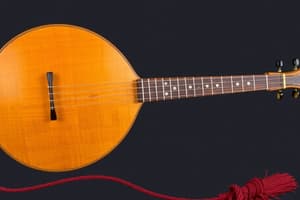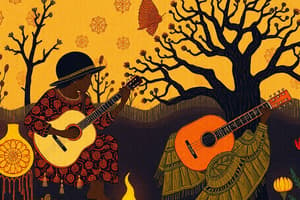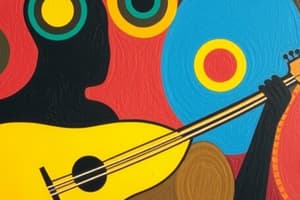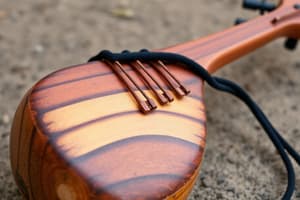Podcast
Questions and Answers
What distinguishes the yidaki's creation from other instruments?
What distinguishes the yidaki's creation from other instruments?
- It involves complex tuning processes.
- It requires specific tools for crafting.
- It is decorated with intricate carvings.
- It utilizes naturally hollowed wood. (correct)
How does the yidaki player maintain a continuous sound?
How does the yidaki player maintain a continuous sound?
- By using a mechanical valve system.
- By storing air in their mouth and breathing through their nose. (correct)
- By inhaling deeply and exhaling slowly.
- By using a bellows system for air supply.
In First Nations Australian lore, what is the significance of the termites in the yidaki's origin story?
In First Nations Australian lore, what is the significance of the termites in the yidaki's origin story?
- They symbolize the spirits of the wind.
- They became stars in the night sky. (correct)
- They guided Burbuk Boon to the eucalyptus branch.
- They represent the ancestors of the instrument makers.
Which aspect of yidaki playing contributes to its unique sonic qualities?
Which aspect of yidaki playing contributes to its unique sonic qualities?
How does the yidaki relate to other instruments like the clapsticks and bull-roarer?
How does the yidaki relate to other instruments like the clapsticks and bull-roarer?
Beyond its musical role, what potential benefit is associated with playing the yidaki?
Beyond its musical role, what potential benefit is associated with playing the yidaki?
What material is used to create a comfortable playing surface on the yidaki?
What material is used to create a comfortable playing surface on the yidaki?
What key element contributed to Burbuk Boon's discovery of the yidaki's sound potential?
What key element contributed to Burbuk Boon's discovery of the yidaki's sound potential?
How does the playing technique of the yidaki differ from that of a tuba or trombone?
How does the playing technique of the yidaki differ from that of a tuba or trombone?
What is the approximate age of the yidaki based on existing evidence?
What is the approximate age of the yidaki based on existing evidence?
Flashcards
Yidaki
Yidaki
A long tube made from a hollowed-out eucalyptus branch, known as didgeridoo.
Playing Technique
Playing Technique
To play the yidaki, you vibrate lips against a wax seal and blow into the tube.
Cheek Puffing
Cheek Puffing
Players puff out cheeks to store air and breathe through the nose while playing.
Animal Sounds
Animal Sounds
Signup and view all the flashcards
Historical Origin
Historical Origin
Signup and view all the flashcards
Burbuk Boon
Burbuk Boon
Signup and view all the flashcards
Clapsticks
Clapsticks
Signup and view all the flashcards
Bull-roarer
Bull-roarer
Signup and view all the flashcards
Yidaki Range
Yidaki Range
Signup and view all the flashcards
Health Benefits
Health Benefits
Signup and view all the flashcards
Study Notes
Yidaki (Didgeridoo)
- The yidaki, also known as a didgeridoo, is a musical instrument
- It's a long, hollowed-out branch of an eucalyptus tree
- It's played by placing lips against a wax seal, vibrating the lips to produce a low-pitched tone
- Players use their breath, along with their nose and mouth, to produce various sounds
- The yidaki can be decorated with paint, burn marks, or carvings
- It is a part of Aboriginal Australian culture and has been used in ceremonies and dances for thousands of years
- A yidaki player can create various animal sounds and mimic other noises.
Clapsticks
- Clapsticks are pairs of long sticks, approximately 8 inches (20 cm) long
- They're used by clapping the sticks together to create a sound
- They are used in conjunction with the yidaki, or to keep time for songs and dances.
Bull-Roarer
- The bull-roarer is a flat, leaf-shaped piece of wood with a cord attached
- It's whirled to produce a low, resonant roar
Studying That Suits You
Use AI to generate personalized quizzes and flashcards to suit your learning preferences.




